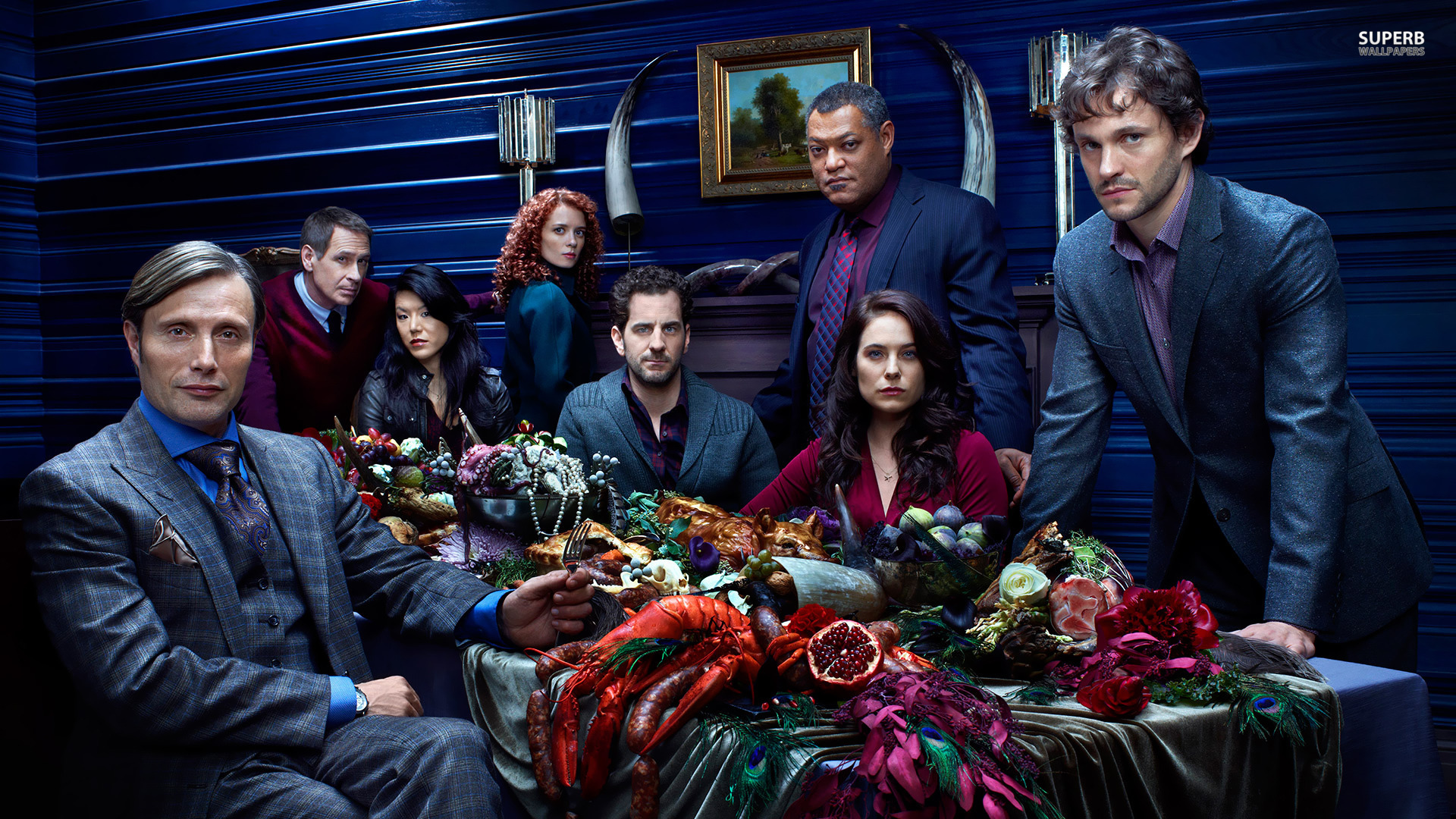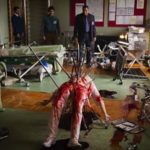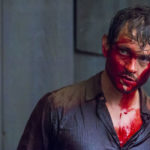Baroque
(bəˈrɒk,-ˈrəʊk/adjective) Relating to or denoting a style of European architecture, music, and art of the 17th and 18th centuries that followed Mannerism and is characterised by ornate detail.
Hannibal is what happens when you take characters from book and movie (Manhunter, Red Dragon, Silence of the Lambs, Hannibal), set them in prequel mode then vamp on the theme to fill out an extended series of series to fill the gaps in characterisation and narrative, much as Gotham was created to fill in the pre-history of Batman and the renowned population of characters therein.
Like Gotham, Hannibal has high production values, a glorious cast and a gothic disposition. Well, partly gothic in its inky darkness, but baroque in its wealth of sumptuous detail. It is highly ornate and mannered in its exploration of three overlapping themes set in a parallel America:
- The existence of multiple serial killers, each with a more bizarre presentation of victims than the last, each alluding to deeper psychological origins, their victims laid out in tableau with distinct iconography, whose relevance is specific to the psychology of each, and whose imagery is repeatedly invoked to illustrate the cumulative impact of each case.
- The impact of these on fragile, vulnerable profiler Will Graham (Hugh Dancy), a man blessed with the rare gift of reenacting crimes, putting himself in the mindset of the killer, taking in all of the evidence and making blinding insights, but at huge cost to his own personal well-being as the killers get inside his head.
- A voyage around Thomas Harris‘s most famous creation, Dr Hannibal “the Cannibal” Lecter, cultured psychiatrist, snappy dresser and psychopath, possessed of the most brilliant mind and a secret life.
In fact, the extension of these themes is wound around a hard core of psychological hypothesis, studied at length but which practitioners may or may not consider total hokum. The extent to which this cod psychology may or may not be relevant but there’s no doubt it captures the attention of a viewing public jaded by the standard formula: X murders Y, Z chases Q until realising in the nick of time it was X all along. Audiences are wise to hackneyed plots and demand a higher level of sophistication all round. Well, many of us do, at any rate.
There is an extent to which Will finds himself framed, and he is an easy scapegoat to frame, being suggestible to the elusive Dr Lecter and chased up by his authoritative but ultimately flawed and obtuse Jack Crawford (Lawrence Fishburne), head of FBI’s behavioural sciences division. It is Jack that puts Will, previously a lecturer at the FBI academy, into these crime scenes, and who ultimately blames himself for Will’s crumbling state of mind, but is blind to the fact that using Dr Lecter as Will’s psychiatrist is putting out the fire with gasoline, as the song puts it.
Ironically, season 1 ends with Will behind bars, being visited by Dr Lecter, a role reversal from what we knew of these characters in the movie Red Dragon but a perfect start to series 2 established by developer, writer, director, executive producer and tea boy (I made up the last one), Bryan Fuller.
But let’s start with Lecter, previously played on screen by Brian Cox and, most famously, Anthony Hopkins. In the shape of Mads Mikkelsen he is sophisticated, urbane, charming, subtle, manipulative, narcissistic and deadpan. His life is portrayed in four vignettes: as aide to the FBI and Will in particular; as a professional to other clients and with a therapist of his own; as bon viveur and lover of culture and fine food; and as serial killer using victims to supply raw ingredients to the exotic dinner parties he hosts.
As an amateur chef, Lecter is to cooking what Sherlock Holmes was to detection: simply the best. As he says in one episode of Dr Abel Gideon (of whom more in a moment), all psychopaths are narcissists – and it takes one to know one. It never enters Lecter’s mind that he might be caught, still less that it might be Graham that catches him (in Red Dragon, for movie buffs.)
Ah yes, Dr Gideon. Maybe the most fascinating character in the series, and deliberately remiscent of Dr Lecter in the future films, Dr Gideon is a psychopathic transplant surgeon behind bars but still in possession of his faculties and sense of humour. He is played, courtesy of a truly inspired move by the casting director, by Eddie Izzard, who as an actor is possessed of a superficially humorous charm quality laced with macabre edginess; you could quite easily believe he was prone to at least some level of psychopathy.
But then that’s the quality you expect to see in Dr Lecter – though this Lecter is altogether more deadpan, and often plays his cards very close to his chest, always having his own secret agenda.
Maybe the makers of this series are playing mind games with the audience? After all, we already knew they had switched the gender of journalist Freddie Lounds (played with a long mane of baroque curls by Lara Jean Chorostecki.) In fact, part of the fun is spotting all the characters we know and love, but I won’t spoil the surprise any further – wait and see!
Talking of mind games, how about this one played out on the audience more than the unfortunate Mr Graham: Will is required by both Dr Lecter and the other resident psychiatrist Dr Alana Bloom (Caroline Dharvernas) to draw a clock. This is actually a standard cognitive dysfunction test for Alzheimer’s disease rather than what you would give to a young hallucinating murder profiler, but disregard that for a moment. The first time we see Lecter do this, Graham draws a circle with a jumble of numbers over on the right-hand side, with Graham apparently unaware he has done anything wrong.
Bloom later asks him to the same; we see from Graham’s perspective what appears to be a perfect clock, though when she shows Lecter it demonstrates that Graham has written the numbers down the right-hand side of the clock. Lecter then takes from his notes a perfectly drawn clock, signed by Will Graham. Which version of reality do you accept?
This is Fuller playing tricks on us, using Graham’s hallucinations and nightmares to cloud our judgement of what is real and what imaginary, much as Danny Boyle did in Trance. But then, I’ve long said that the traditional black v white portrait in movies and TV series is no longer acceptable, and that mature audiences cope well with ambivalence.
Flashiness apart, what we are left is a swirling undercurrent of the psychology of older cases and their impact on Graham, especially the role played by daughter of serial killer “The Minnesota Shrike” (Garret Jacob Hobbs played by Vladimir Jon Cubrt), Abigail Hobbs (Kacey Rohl.) That and wondering about the significance of moose horns and a host of other imagery, plus a host of nods to Dario Argento and David Cronenberg. In fact, influences go further. Courtesy of Wikipedia:
Fuller stated: “When I sat down to the script, I was very consciously saying, ‘What would David Lynch do with a Hannibal Lecter character? What sort of strange, unexpected places would he take this world?’ I’m a great admirer of his work and his aesthetic and his meticulous sound design. Those were all components that I felt very strongly needed to be part of our Hannibal Lecter story. Between Lynch and Kubrick, there’s a lot of inspiration.” Fuller also cited David Cronenberg and Dario Argento as influences on the series. Fuller cited Tony Scott as an influence for the third season.
All you need to know is that this is cleverly-constructed TV drama, where the dark comedy is so straight-faced you could easily miss it entirely, and given an 18 certificate since the bloodiness of deconstructed corpses would easily leave many an audience member more than queasy. But for those that remain, enjoy the baroque splendour in muted colours. All it needs is a harpsichord theme music rather than Brian Reitzell‘s spooky score – but then it turns out that the polymath Dr Lecter owns a harpsichord too. Nudge nudge, wink wink.
So basically much enjoyable hokum and plenty for the cognoscenti to spot, even if psychologists and psychiatrists in the audience may snort indignantly at how their professions are portrayed and the dialogue purporting to represent the same. The critics (see below) and the Emmy judges liked it, so that’s all that matters. Or is it? NBC cancelled after two series, but luckily for us Netflix stepped in. Keep watching – there is more to come!
Season 1
Reviews for the first season were positive. On critic website Metacritic, the first season scored 70 out of 100 based on 32 reviews, which constitutes “generally favorable reviews”. Joanne Ostrow of The Denver Post praised the series as a “… well constructed, masterfully written piece,” but stated “… this level of violent imagery is not my cup of tea…” She also had high praise for the characters, stating that they are “… so compelling, however, that you may give in to the gore-fest.” Paul Doro of Shock Till You Drop gave Hannibal an 8/10 and said of the series, “The stab at classy horror mostly succeeds due to excellent performances from the leads, genuine suspense and surprises, well-constructed short and long-term mysteries, and an appropriately disconcerting mood that permeates the action right from the start…” and praised Hugh Dancy in particular, saying he “… does an outstanding job of subtlety conveying how painful human interaction is for him, and despite being abrasive and unpleasant, you are always in his corner and really feel for the guy.”[102] Jeff Jensen of Entertainment Weekly gave the show an A- and called it “… finely acted, visually scrumptious, and deliciously subversive.”
Brian Lowry of Variety said Hannibal is “… the tastiest drama the network has introduced in awhile,” and had particular praise for the central trio of Dancy, Mikkelsen and Fishburne. Eric Goldman of IGN gave the series a 9/10, which constitutes a score of “Amazing”. He said, “A prequel TV series about Hannibal Lecter has to overcome a lot of preconceptions … But guess what? None of that matters when you actually watch the show, because Hannibal is terrific.” Linda Stasi of The New York Post gave the series two and a half stars out of four, praising the performances and called it “… The most beautifully shot and produced show on network TV, with many scenes simply and literally breathtaking…” Jeff Simon from The Buffalo News called Hannibal “deeply sinister” and “brilliant.” The Chicago Sun Times‘ TV critic Lori Rackl said, “Hannibal is a haunting, riveting… drama that has the look and feel of a show audiences have become more accustomed to seeing on cable than broadcast,” and concluded that “It’s also extremely well executed… bound to leave viewers hungry for more.” Alan Sepinwall of HitFix called Hannibal “creepy, haunting, smart, utterly gorgeous…” and the best of this season’s serial killer shows. Sepinwall also praised the character of Hannibal, writing he has been made into a believable supervillain without making the police force and others look incompetent. Reflecting on the completed first season, The A.V. Club‘s Todd VanDerWerff wrote that the series acts as a corrective to the “empty” violence on much of television and “restores the seriousness of purpose to a genre long in need of it…. Hannibal is interested in death and murder as a means to glance sidelong at some of life’s largest questions. When not functioning as a cop drama, it’s an intricately twisted serial-killer thriller, but it’s also a surprisingly deep series about psychiatry and the state of the human mind.” VanDerWerff concluded that Fuller had taken a series “that had every reason to be a cheap cash-in and has, instead, turned into one of TV’s best shows.”
Other reviews were less favorable. Glenn Garvin from The Miami Herald called it “a fast-food hash of poor planning and worse execution…”, referring to the writing as “a mess of unmemorable dialogue and unworkable characterizations.” Matthew Gilbert of The Boston Globe was similarly critical, calling the series “rank and depressing,” and concluded that it is “shocking, gruesome, and, ultimately, hollow.”

















